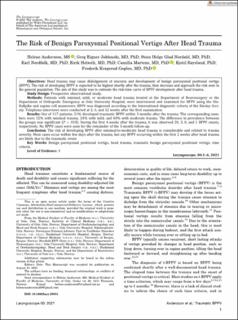| dc.description.abstract | Objectives: Head trauma may cause dislodgement of otoconia and development of benign paroxysmal positional vertigo (BPPV). The risk of developing BPPV is expected to be highest shortly after the trauma, then decrease and approach the risk seen in the general population. The aim of this study was to estimate the risk-time curve of BPPV development after head trauma.
Study Design: Prospective observational study.
Methods: Patients with minimal, mild, or moderate head trauma treated at the Department of Neurosurgery or the Department of Orthopedic Emergency at Oslo University Hospital, were interviewed and examined for BPPV using the Dix-Hallpike and supine roll maneuvers. BPPV was diagnosed according to the International diagnostic criteria of the Bárány Society. Telephone interviews were conducted at 2, 6, and 12 weeks after the first examination.
Results: Out of 117 patients, 21% developed traumatic BPPV within 3 months after the trauma. The corresponding numbers were 12% with minimal trauma, 24% with mild, and 40% with moderate trauma. The difference in prevalence between the groups was significant (P = .018). During the first 4 weeks after the trauma, it was observed 20, 3, 0, and 1 BPPV onsets, respectively. No BPPV cases were seen for the remainder of the 3-month follow-up.
Conclusion: The risk of developing BPPV after minimal-to-moderate head trauma is considerable and related to trauma severity. Most cases occur within few days after the trauma, but any BPPV occurring within the first 2 weeks after head trauma are likely due to the traumatic event. | en_US |

